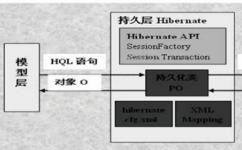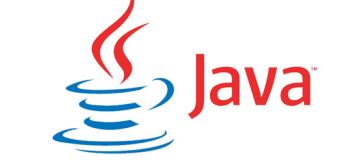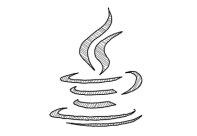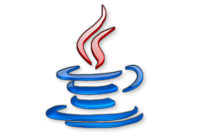一、单项选择题
1.Java是从()语言改进重新设计。
A.Ada B.C++ C.Pasacal D.BASIC
答案:B
2.下列语句哪一个正确()
A. Java程序经编译后会产生machine code
B. Java程序经编译后会产生byte code
C. Java程序经编译后会产生DLL
D.以上都不正确
答案:B
3.下列说法正确的有()
A. class中的constructor不可省略
B. constructor必须与class同名,但方法不能与class同名
C. constructor在一个对象被new时执行
D.一个class只能定义一个constructor
答案:C
4.提供Java存取数据库能力的包是()
A.java.sql B.java.awt C.java.lang D.java.swing
答案:A
5.下列运算符合法的是()
A.&& B.<> C.if D.:=
答案:A
6.执行如下程序代码
a=0;c=0;
do{
--c;
a=a-1;
}while(a>0);
后,C的值是()
A.0 B.1 C.-1 D.死循环
答案:C
7.下列哪一种叙述是正确的()
A. abstract修饰符可修饰字段、方法和类
B.抽象方法的body部分必须用一对大括号{ }包住
C.声明抽象方法,大括号可有可无
D.声明抽象方法不可写出大括号
答案:D
8.下列语句正确的是()
A.形式参数可被视为local variable
B.形式参数可被字段修饰符修饰
C.形式参数为方法被调用时,真正被传递的参数
D.形式参数不可以是对象
答案:A
9.下列哪种说法是正确的()
A.实例方法可直接调用超类的实例方法
B.实例方法可直接调用超类的类方法
C.实例方法可直接调用其他类的实例方法
D.实例方法可直接调用本类的类方法
答案:D
二、多项选择题
1.Java程序的种类有()
A.类(Class) B.Applet C.Application D.Servlet
2.下列说法正确的有()
A.环境变量可在编译source code时指定
B.在编译程序时,所能指定的环境变量不包括class path
C. javac一次可同时编译数个Java源文件
D. javac.exe能指定编译结果要置于哪个目录(directory)
答案:BCD
3.下列标识符不合法的有()
A.new B.$Usdollars C.1234 D.car.taxi
答案:ACD
4.下列说法错误的有()
A.数组是一种对象
B.数组属于一种原生类
C. int number=[]={31,23,33,43,35,63}
D.数组的大小可以任意改变
答案:BCD
5.不能用来修饰interface的有()
A.private B.public C.protected D.static
答案:ACD
6.下列正确的有()
A. call by value不会改变实际参数的数值
B. call by reference能改变实际参数的参考地址
C. call by reference不能改变实际参数的参考地址
D. call by reference能改变实际参数的内容
答案:ACD
7.下列说法错误的有()
A.在类方法中可用this来调用本类的类方法
B.在类方法中调用本类的类方法时可直接调用
C.在类方法中只能调用本类中的类方法
D.在类方法中绝对不能调用实例方法
答案:ACD
8.下列说法错误的有()
A. Java面向对象语言容许单独的过程与函数存在
B. Java面向对象语言容许单独的方法存在
C. Java语言中的方法属于类中的成员(member)
D. Java语言中的方法必定隶属于某一类(对象),调用方法与过程或函数相同
答案:ABC
9.下列说法错误的有()
A.能被java.exe成功运行的java class文件必须有main()方法
B. J2SDK就是Java API
C. Appletviewer.exe可利用jar选项运行.jar文件
D.能被Appletviewer成功运行的java class文件必须有main()方法
答案:BCD
三、判断题
1.Java程序中的起始类名称必须与存放该类的文件名相同。()
答案:正确
2.Unicode是用16位来表示一个字的。()
答案:正确
3.原生类中的数据类型均可任意转换。()
答案:错误
1.分别写出BOOL,int,float,指针类型的变量a 与“零”的比较语句。
答案:
BOOL : if ( !a ) or if(a)
int : if ( a == 0)
float : const EXPRESSION EXP = 0.000001
if ( a < EXP && a >-EXP)
pointer : if ( a != NULL) or if(a == NULL)
2.请说出const与#define 相比,有何优点?
答案:1) const 常量有数据类型,而宏常量没有数据类型。编译器可以对前者进行类型安全检查。而对后者只进行字符替换,没有类型安全检查,并且在字符替换可能会产生意料不到的错误。
2) 有些集成化的调试工具可以对const 常量进行调试,但是不能对宏常量进行调试。
3.简述数组与指针的区别?
数组要么在静态存储区被创建(如全局数组),要么在栈上被创建。指针可以随时指向任意类型的内存块。
(1)修改内容上的差别
char a[] = “hello”;
a[0] = ‘X’;
char *p = “world”; // 注意p 指向常量字符串
p[0] = ‘X’; // 编译器不能发现该错误,运行时错误
(2) 用运算符sizeof 可以计算出数组的容量(字节数)。sizeof(p),p 为指针得到的是一个指针变量的字节数,而不是p 所指的内存容量。C++/C 语言没有办法知道指针所指的内存容量,除非在申请内存时记住它。注意当数组作为函数的参数进行传递时,该数组自动退化为同类型的指针。
char a[] = "hello world";
char *p = a;
cout<< sizeof(a) << endl; // 12 字节
cout<< sizeof(p) << endl; // 4 字节
计算数组和指针的内存容量
void Func(char a[100])
{
cout<< sizeof(a) << endl; // 4 字节而不是100 字节
}
4.类成员函数的重载、覆盖和隐藏区别?
答案:
a.成员函数被重载的特征:
(1)相同的范围(在同一个类中);
(2)函数名字相同;
(3)参数不同;
(4)virtual 关键字可有可无。
b.覆盖是指派生类函数覆盖基类函数,特征是:
(1)不同的范围(分别位于派生类与基类);
(2)函数名字相同;
(3)参数相同;
(4)基类函数必须有virtual 关键字。
c.“隐藏”是指派生类的函数屏蔽了与其同名的基类函数,规则如下:
(1)如果派生类的函数与基类的函数同名,但是参数不同。此时,不论有无virtual关键字,基类的函数将被隐藏(注意别与重载混淆)。
(2)如果派生类的函数与基类的函数同名,并且参数也相同,但是基类函数没有virtual 关键字。此时,基类的函数被隐藏(注意别与覆盖混淆)
5. There are two int variables: a and b, don’t use “if”, “? :”, “switch”or other judgement statements, find out the biggest one of the two numbers.
答案:( ( a + b ) + abs( a - b ) ) / 2
6. 如何打印出当前源文件的文件名以及源文件的当前行号?
答案:
cout << __FILE__ ;
cout<<__LINE__ ;
__FILE__和__LINE__是系统预定义宏,这种宏并不是在某个文件中定义的,而是由编译器定义的。
7. main 主函数执行完毕后,是否可能会再执行一段代码,给出说明?
答案:可以,可以用_onexit 注册一个函数,它会在main 之后执行int fn1(void), fn2(void), fn3(void), fn4 (void);
void main( void )
{
String str("zhanglin");
_onexit( fn1 );
_onexit( fn2 );
_onexit( fn3 );
_onexit( fn4 );
printf( "This is executed first.\n" );
}
int fn1()
{
printf( "next.\n" );
return 0;
}
int fn2()
{
printf( "executed " );
return 0;
}
int fn3()
{
printf( "is " );
return 0;
}
int fn4()
{
printf( "This " );
return 0;
}
The _onexit function is passed the address of a function (func) to be called when the program terminates normally. Successive calls to _onexit create a register of functions that are executed in LIFO (last-in-first-out) order. The functions passed to _onexit cannot take parameters.
8. 如何判断一段程序是由C 编译程序还是由C++编译程序编译的?
答案:
#ifdef __cplusplus
cout<<"c++";
#else
cout<<"c";
#endif
9.文件中有一组整数,要求排序后输出到另一个文件中
答案:
#i nclude
#i nclude
using namespace std;
void Order(vector& data) //bubble sort
{
int count = data.size() ;
int tag = false ; // 设置是否需要继续冒泡的标志位
for ( int i = 0 ; i < count ; i++)
{
for ( int j = 0 ; j < count - i - 1 ; j++)
{
if ( data[j] > data[j+1])
{
tag = true ;
int temp = data[j] ;
data[j] = data[j+1] ;
data[j+1] = temp ;
}
}
if ( !tag )
break ;
}
}
void main( void )
{
vectordata;
ifstream in("c:\\data.txt");
if ( !in)
{
cout<<"file error!";
exit(1);
}
int temp;
while (!in.eof())
{
in>>temp;
data.push_back(temp);
}
in.close(); //关闭输入文件流
Order(data);
ofstream out("c:\\result.txt");
if ( !out)
{
cout<<"file error!";
exit(1);
}
for ( i = 0 ; i < data.size() ; i++)
out<
10. 链表题:一个链表的结点结构
struct Node
{
int data ;
Node *next ;
};
typedef struct Node Node ;
(1)已知链表的头结点head,写一个函数把这个链表逆序 ( Intel)
Node * ReverseList(Node *head) //链表逆序
{
if ( head == NULL || head->next == NULL )
return head;
Node *p1 = head ;
Node *p2 = p1->next ;
Node *p3 = p2->next ;
p1->next = NULL ;
while ( p3 != NULL )
{
p2->next = p1 ;
p1 = p2 ;
p2 = p3 ;
p3 = p3->next ;
}
p2->next = p1 ;
head = p2 ;
return head ;
}
(2)已知两个链表head1 和head2 各自有序,请把它们合并成一个链表依然有序。(保留所有结点,即便大小相同)
Node * Merge(Node *head1 , Node *head2)
{
if ( head1 == NULL)
return head2 ;
if ( head2 == NULL)
return head1 ;
Node *head = NULL ;
Node *p1 = NULL;
Node *p2 = NULL;
if ( head1->data < head2->data )
{
head = head1 ;
p1 = head1->next;
p2 = head2 ;
}
else
{
head = head2 ;
p2 = head2->next ;
p1 = head1 ;
}
Node *pcurrent = head ;
while ( p1 != NULL && p2 != NULL)
{
if ( p1->data <= p2->data )
{
pcurrent->next = p1 ;
pcurrent = p1 ;
p1 = p1->next ;
}
else
{
pcurrent->next = p2 ;
pcurrent = p2 ;
p2 = p2->next ;
}
}
if ( p1 != NULL )
pcurrent->next = p1 ;
if ( p2 != NULL )
pcurrent->next = p2 ;
return head ;
}
(3)已知两个链表head1 和head2 各自有序,请把它们合并成一个链表依然有序,这次要求用递归方法进行。 (Autodesk)
答案:
Node * MergeRecursive(Node *head1 , Node *head2)
{
if ( head1 == NULL )
return head2 ;
if ( head2 == NULL)
return head1 ;
Node *head = NULL ;
if ( head1->data < head2->data )
{
head = head1 ;
head->next = MergeRecursive(head1->next,head2);
}
else
{
head = head2 ;
head->next = MergeRecursive(head1,head2->next);
}
return head ;
}


 喜欢
喜欢  顶
顶 难过
难过 囧
囧 围观
围观 无聊
无聊



